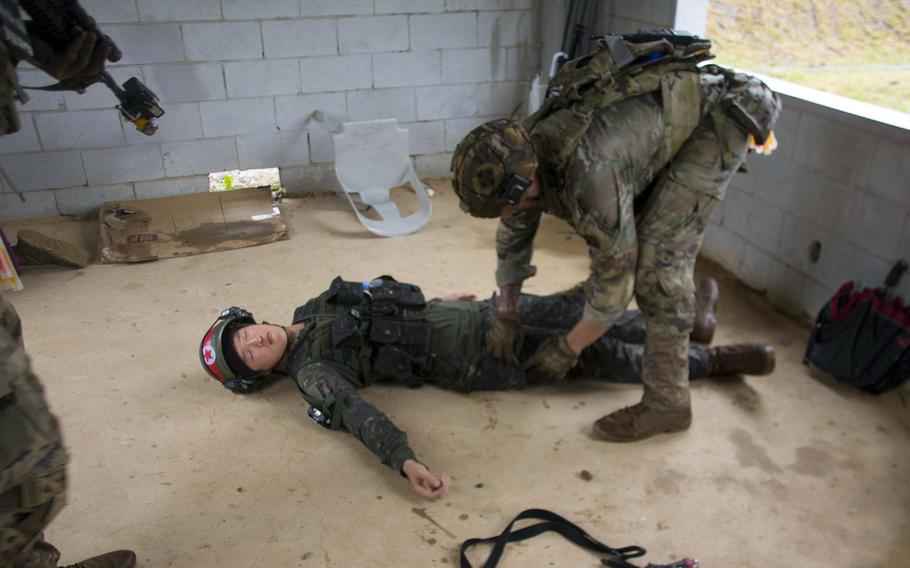
A U.S. soldier searches a mock insurgent during an Ulchi Freedom Shield drill in Paju, South Korea, Wednesday, Aug. 23, 2023. (Christopher Green/Stars and Stripes)
PAJU, South Korea — A torrential downpour prompted flood warnings Wednesday near the border with North Korea, but U.S. Strykers and South Korean tanks kept rolling.
About 500 U.S. and South Korean troops practiced their street-fighting skills in the Urban Area Operating Center, a simulated city block eight miles from the Demilitarized Zone separating North and South Korea.
“We love the rain,” Army 1st. Lt. Robert Beverage, a 4th Infantry Division platoon leader, told reporters at the site. “We’re an infantry unit; this is what we signed up to do.”
The urban combat drill was part of Ulchi Freedom Shield, a semiannual, 11-day exercise by the U.S. and South Korea, one of the largest military exercises the allies conduct on the peninsula.
About 70 of the troops were U.S. soldiers from the 2nd Stryker Brigade Combat Team, 4th Infantry Division, the rotational unit deployed to South Korea from Fort Carson, Colo.
The Americans and South Koreans took turns assaulting and defending the mock city block throughout the day.
South Korean K1A1 tanks and U.S. Strykers equipped with remotely operated .50 caliber machine guns rolled through streets studded with ordinary landmarks: subway entrances, overhead street signs and six-story apartment buildings.
Soldiers in the drill were equipped with South Korea’s Multiple Integrated Laser Engagement System, which simulates a bullet’s direction after being fired and its impact on the body, to provide the realism of actual combat.
At one point, Stryker brigade soldiers holed up in an apartment complex, waiting for the opportune moment to clear an adjacent building occupied by South Korean soldiers simulating enemy forces.
During the short reprieve, South Korean troops embedded with the brigade translated and relayed messages over a radio, telling U.S. soldiers whether it was safe to cross the open ground between the buildings.
“Communication has definitely been a challenge as we’re working with the [South Korean] army, but my platoon is attached to some really good Korean soldiers that help us bridge that gap,” Beverage said.
Over 30 separate drills, some with seven other nations in U.N. Command, are underway during Ulchi Freedom Shield. The exercises test the allies’ interoperability — the ability of one nation’s military to use another’s training methods and equipment — against regional threats, namely North Korea.
South Korean President Yoon Suk Yeol was briefed Wednesday on the exercise by the country’s military and U.S. Forces Korea at Command Post Tango in Seongnam city, according to a news release from the presidential office that day.
Ulchi Freedom Shield is training troops to be prepared for “a rapid war within a short period of time,” Yoon said in the release. The exercise also addresses scenarios that reflect “North Korea’s advanced nuclear and missile capabilities” and the U.S.-South Korea’s response to those threats, he added.
North Korea, which labels the joint exercises a rehearsal for an invasion, condemned Ulchi Freedom Shield and warned it could spark a “thermonuclear war,” according to the state-run Korean Central News Agency on Tuesday.
A North Korean attempt on Thursday to put a military satellite into orbit failed due to issues with the rocket booster, according to a KCNA report that day.
It was Pyongyang’s second failed attempt since May to put a satellite in orbit. The North’s aerospace division said it would review Thursday’s launch and attempt another in October, according to KCNA.
U.S. Indo-Pacific Command in a news release Thursday said North Korea’s satellite launch used the same technology for ballistic missile launches and that “despite its failure, is a brazen violation” of U.N. Security Council resolutions.